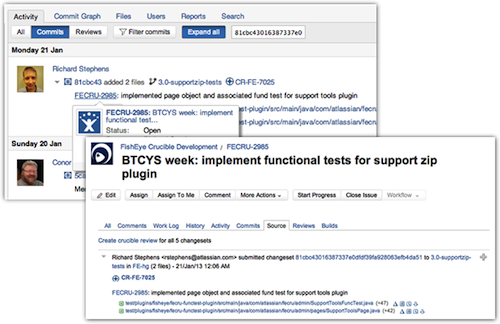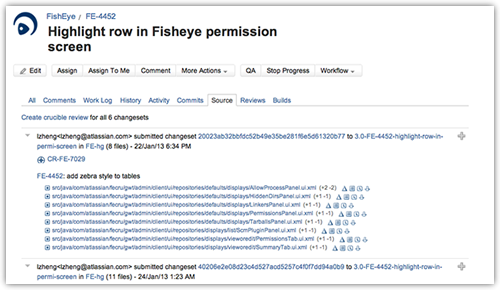“I remember when our team was just two developers…”. Have you made a statement like that recently? At Atlassian our development team grew from 2 guys to now over 300 developers working in different timezones. Collaborating on the code became more complex as the team was growing but the goal always stayed the same: improve dev speed and ship high quality code. To achieve this we needed to find the right processes, tools and workflows. In our case we just built some of it ourselves.
Fisheye and Crucible were created to help development teams function as smoothly as possible using a common interface to browse source repositories, investigate the code history and easily review the modifications in various SCMs. We required a great integration with Jira to track the changes in the source related to the development tasks. Jira is now used by more than 20,000 organizations worldwide and it’s partly thanks to these two products. Let me tell you here in which ways you can link your issues and your source together to ensure your releases are of top quality.
A simple and straigthforward integration
First comes the integration between Fisheye, Crucible and Jira. We recently re-architected the way the applications talk to each other to achieve simplicity. Only a single link between your Jira server and your Fisheye and Crucible instance will be needed to get all the power of the integration.
- Always see in Jira the list of source changes related to an issue.
- Create reviews directly from Jira and automatically have them linked back to your issues.
- View details of your issues in Fisheye and Crucible in your source, commits or reviews
- Create issues from Crucible during your reviews without the need to change applications.
- Use Jira for user management reducing the overhead of managing multiple sets of users.
The new improvements introduced in the latest releases can connect all Jira projects, Fisheye repositories and Crucible projects together without requiring any extra configuration because we do not want you to spend your time in the configuration pages of the administration interface.

Track outstanding work in Jira while doing code reviews
With Crucible 2.10 we have improved Jira issue creation from reviews with what we call the Inline Issue Creation. Reviewers can now create issues and subtasks in Jira without having to leave Crucible.
No more jumping back and forth between applications; Crucible will offer you a direct interaction with Jira to let you keep track of outstanding work that you identify while you’re reviewing the code of your peers.
We know that context matters when you look at issues. That’s why we added a mention of the original review to the issue page in Jira. So that you can always know where tasks are coming from and get all the information necessary to understand what needs to be done.

Link all the source, no matter where it is
With Fisheye’s new integration to Jira you will never miss a changeset linked to your development tasks. It has been designed to find and reference every changeset back to the Jira issue mentioned in a commit message of the repositories indexed by your instance.
Often times you need to touch multiple repositories to resolve an issue. And for some organisations those repositories may be managed with different SCMs. This is the case where Fisheye and Crucible offer a unique way to cross-reference your source, reviews and issues no matter what type of SCM you are using and no matter where your repositories are located. And of course, we respect the sensitivity of your data and we allow access to be restricted.

Give it a try, let us know what you think
If you’re using Jira with your development and already have Fisheye and Crucible have a look at the new integrations and let us know what you think. If you haven’t tried Fisheye and Crucible yet, check the link below and give us your feedback!
